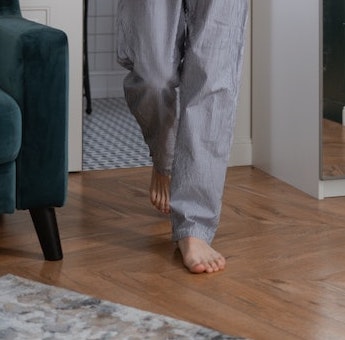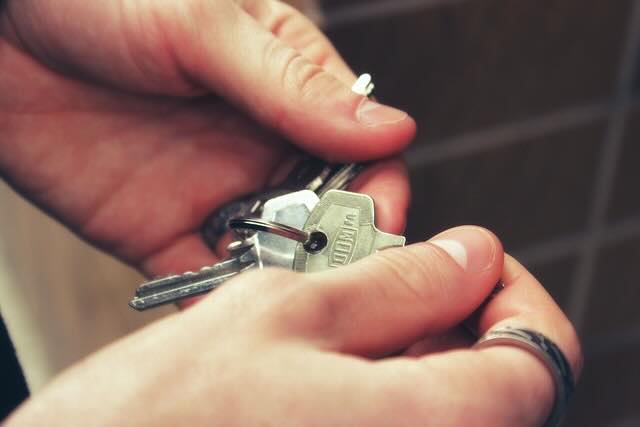Sharing a living space comes with its unique set of challenges and experiences. One intriguing situation you might find yourself in is cohabiting with a roommate who’s perpetually on the move, pacing around the apartment or house at all hours. Such constant motion can spark curiosity, concern, and sometimes, even irritation.
In this article we explore why some individuals feel the compulsion to continuously move, the pros and cons of such behavior, and strategies to ensure a harmonious coexistence. Whether you’re the one always on your feet or the observer wondering why, this article offers insights, answers, and actionable tips for a balanced shared living environment.

Table of Contents
Understanding the Habit: Why Some Roommates are Always on the Move
Living with someone who’s always on their feet can be puzzling, but there are several reasons, both psychological and physiological, behind this behavior:
Psychological Factors Behind Constant Movement
Movement, especially pacing, can be a way for some individuals to process their thoughts, manage stress, or cope with anxiety.
- Self-Soothing Mechanism: According to a study by Harvard Medical School, pacing can serve as a self-soothing mechanism for some. It provides a rhythmic, repetitive action that can help regulate emotions, especially during heightened states of stress or anxiety.
- Processing Thoughts: Movement can aid in cognitive processing. A Stanford research showed that walking boosts creative inspiration. The act of walking itself, not the environment, was the key factor. Participants in the study experienced an increase of 60% in creative output when walking.
Physiological Reasons for Frequent Movement
- Restlessness and Energy: Some people have naturally higher metabolic rates which lead to increased energy. This energy needs an outlet, and walking or pacing can provide that.
- Counteracting Sedentary Lifestyle: According to the World Health Organization, a significant portion of adults worldwide lead sedentary lifestyles. Those who sit for prolonged periods during the day (for work or study) might feel the urge to move around more at home to compensate for the lack of physical activity.
- Medical Conditions: Some medical conditions, such as Restless Leg Syndrome (RLS) or Attention Deficit Hyperactivity Disorder (ADHD), can cause individuals to move around frequently. A study published in the National Library of Medicine discussed how RLS leads to an irresistible urge to move the legs, often resulting in pacing or walking around.
Understanding these factors can help roommates develop empathy and find effective solutions for harmonious cohabitation. Before jumping to conclusions, it’s crucial to communicate with your roommate and understand the underlying reasons for their constant movement.
Roommate is constantly walking around: The Pros and Cons
Living with a roommate who’s always on the move can be a mixed bag. While there are unique benefits to such a dynamic, there can also be some challenges that arise. Let’s delve into the pros and cons of this behavior:
The Benefits of Having an Active Roommate
- Inspiration to Stay Active: Observing someone constantly on the move can motivate you to incorporate more physical activity into your own routine. As the saying goes, “motion begets motion”.
- A Lively Atmosphere: A moving roommate can lend a dynamic and vibrant energy to the shared space, preventing it from feeling stagnant.
- Lesser Chores for You: If they’re walking around doing household tasks, it might mean fewer chores for you. Movement doesn’t always equate to aimless pacing; they could be tidying up, organizing, or even cooking.
- Safety: Having someone active, especially during odd hours, can be a deterrent for potential intruders, adding a layer of security to your living space.
- Potential for Bonding: Their constant movement might be due to hobbies like dancing, yoga, or aerobics. This could be an opportunity for both of you to bond over shared activities.
Potential Annoyances and Challenges
- Disturbance in Quiet Time: If you’re someone who values quiet time or needs concentration, a constantly moving roommate can be distracting.
- Sleep Disruptions: Especially if your roommate is active during the night or early morning, it might interfere with your sleep patterns.
- Space Intrusion: Constant movement can sometimes feel like an invasion of personal space, particularly in confined living arrangements.
- Wear and Tear: More movement, especially if it involves other activities, can lead to quicker wear and tear of shared household items or furniture.
- Misunderstandings and Miscommunication: Without proper communication, you might misinterpret their behavior as restlessness or anxiety, leading to unwarranted concern or potential disagreements.
Recognizing these pros and cons is the first step towards ensuring a harmonious living situation. It provides a foundation for open dialogue, where both roommates can express their feelings, set boundaries, and find mutual solutions.
The Roommate’s Perspective: Walking as a Stress Reliever
Before drawing any conclusions about your roommate’s frequent movements, it’s essential to look at the situation from their perspective. Walking, pacing, or being continually active isn’t always a mere quirk; for many, it’s a genuine and valuable coping mechanism.
The Deep Connection Between Walking and Mental Well-being
- Walking as Meditation: For many, the repetitive action of walking serves as a form of moving meditation. Each step can anchor them to the present moment, pushing away overwhelming thoughts and grounding them. Research from Harvard Medical School has shown that mindfulness walking can reduce anxiety and boost overall mental health.
- Boosting Endorphins: Physical activity, even as simple as walking, releases endorphins — the body’s natural painkillers and mood elevators. These chemicals can produce feelings of euphoria, similar to a “runner’s high.”
- Distracting the Mind: Walking or moving around can serve as a productive distraction from distressing emotions or thoughts. By focusing on the motion, one can divert their attention from ruminative or negative patterns.
Physical Health Benefits of Regular Movement
- Improved Circulation: Continuous movement aids in blood flow, ensuring that vital nutrients reach cells and toxins are flushed away. Proper circulation can lead to enhanced energy and reduced fatigue.
- Muscle Engagement: Even light walking engages multiple muscle groups, ensuring they remain active and preventing stiffness, especially after long periods of sitting.
- Better Digestion: Believe it or not, walking can even aid in digestion. A stroll post meals can assist in the smooth processing of food, as suggested by this study.
- Improved Sleep: Regular movement throughout the day can lead to better sleep patterns at night. The National Sleep Foundation states that physical activity can help insomniacs get better sleep.
Understanding your roommate’s perspective is about empathy. Recognizing that their movement isn’t just about physical activity but also their mental and emotional well-being can pave the way for better cohabitation. After all, shared living is as much about understanding as it is about adjusting.
Living in Harmony: Finding Common Ground
Harmonious coexistence with a roommate who’s always on the move is not just a dream; it’s an achievable reality. With the right approach and mutual respect, both roommates can find a middle ground that caters to their unique needs.
Embracing Open Dialogue
- Regular Check-ins: Establish a habit of regular check-ins with your roommate. This not only fosters open communication but also ensures that both of you are on the same page regarding each other’s habits and preferences.
- Express Your Feelings Without Accusation: Instead of saying, “You’re always walking around, and it’s annoying,” try, “I’ve noticed you move around a lot. Can we discuss how we can make our shared space comfortable for both of us?”
- Listen Actively: When discussing concerns or preferences, ensure you are genuinely listening to your roommate’s side of the story. This builds trust and demonstrates that you value their perspective.
Adapting Shared Spaces for Mutual Comfort
- Zoning Areas: Consider designating specific areas for relaxation and activity. For instance, perhaps the living room can have periods where it’s a ‘quiet zone,’ while at other times, it’s open for movement.
- Noise Management: If the sound of movement is a concern, think about investing in noise-reducing rugs, curtains, or even noise-canceling headphones.
- Flexible Furniture Layout: Opt for a flexible furniture arrangement that allows easy reconfiguration, catering to both stationary activities like reading and dynamic ones like exercising.
Compromise and Adjust
- Shared Activity Sessions: Maybe you can set specific times during the day where both of you engage in some form of physical activity, turning a potential disturbance into a bonding experience.
- Establish Quiet Hours: Agree on certain hours, especially during the night or early morning, when movement is minimized to ensure undisturbed rest.
- Respect Boundaries: Recognize that each individual has personal boundaries. A constant walker should be mindful not to invade personal space, while the other should understand the reasons behind their roommate’s need for movement.
Seek External Solutions if Needed
- Professional Mediation: If conflicts persist, consider seeking a mediator or counselor who specializes in roommate or shared living situations. They can offer neutral perspectives and effective solutions.
- Engage in Joint Activities: Participate in activities outside the home, like group classes or walks, to foster understanding and camaraderie.
Remember, the key to living in harmony, even with differing habits, is understanding and mutual respect. By addressing the issue head-on, communicating openly, and being willing to adjust and compromise, roommates can create a shared living environment that feels like home for both.
Tips to Address a Roommate’s Excessive Movement
Having a roommate who’s always in motion can be a unique challenge. However, with a constructive approach, it’s possible to address the situation amicably and ensure that both of you feel at ease in your shared space.
Build Empathy and Understanding
- Educate Yourself: Before addressing the situation, familiarize yourself with potential reasons someone might move around a lot. This knowledge can help approach the conversation with empathy.
- Ask Open-Ended Questions: Instead of confronting, ask questions like, “I’ve noticed you often like to walk around. Is there a particular reason for this?” Such inquiries promote understanding and reduce defensiveness.
Set Clear Boundaries
- Define Shared Spaces: Clearly delineate which areas are communal and which ones are private. This ensures that while your roommate can move around, they’re also aware of the zones they should tread carefully around.
- Schedule ‘Quiet Hours’: Agree upon certain hours of the day where minimal movement, especially in shared spaces, is encouraged. This could be during early mornings, late nights, or any specific hours you require focused calm.
Suggest Alternatives
- Introduce Indoor Exercise: If your roommate’s movement is tied to a need for physical activity, suggest indoor exercises that are quieter but equally effective, such as yoga or pilates.
- Recommend Outdoor Activities: Encourage them to take some of their activities outside, whether it’s a walk in the park, jogging, or even joining group fitness sessions.
Ensure Effective Communication
- Choose the Right Time: Address the topic at a time when both of you are relaxed and free from distractions. Avoid broaching the subject during heightened emotions or stress.
- Use ‘I’ Statements: Framing your concerns using “I feel” or “I’ve noticed” rather than accusatory “you” statements can make the conversation more productive.
Invest in Practical Solutions
- Soundproofing: If noise is a significant issue, consider soundproofing solutions like adding rugs, installing door sweeps, or using wall hangings to dampen the sound.
- Room Dividers: In open spaces, room dividers can create an illusion of separate zones and provide a visual reminder of personal spaces.
Seek Mutual Activities
- Bond Over Shared Interests: Find activities both of you enjoy and can do together, be it watching a movie, cooking, or even taking a stroll. This can help divert some of the excessive movement into joint activities, fostering better rapport.
- Engage in Relaxation Techniques: Introduce your roommate to relaxation techniques like deep breathing, meditation, or even calming music. Sometimes, these can act as effective substitutes for constant movement.
Remember, the objective is not to curtail your roommate’s natural tendencies but to find a middle ground where both of you feel comfortable and respected in the shared living space.
Finding Balance: A Peaceful Living Environment
Achieving a peaceful living environment with a roommate who’s in perpetual motion might seem like a challenge, but with patience, understanding, and proactive measures, it’s entirely feasible. Balance doesn’t mean suppressing one’s habits but finding mutual respect and shared solutions.
Understand the Root Cause
- Engage in Heart-to-Heart Conversations: Initiate a non-confrontational dialogue to understand the reasons behind their constant movement. Often, understanding the “why” can make it easier to navigate the “how.”
- Observe Without Judgement: Before jumping to conclusions, observe their patterns. Do they move more during certain times of the day or after specific activities? This observation can provide insights into their behavior.
Introduce Calming Activities
- Shared Quiet Times: Dedicate certain times of the day for shared calm activities like reading, listening to soft music, or even meditating together.
- Indoor Plants: Introducing greenery can have a calming effect. Plants like lavender, chamomile, and snake plants are known for their soothing properties and can add tranquility to your shared space.
Redesign Shared Spaces
- Flexible Layouts: Consider rearranging your living environment to accommodate both stillness and movement. Movable furniture or partitioned areas can create adaptable zones.
- Create Personal Sanctuaries: Each roommate can have a designated area, tailored to their needs. For instance, a quiet reading nook for you and a mini workout or pacing area for them.
Introduce Structured Routines
- Synchronized Schedules: While complete synchronization isn’t practical, aligning certain activities, like meal times or relaxation hours, can create pockets of calm.
- Shared Responsibilities: Convert some of their movement into shared chores. This way, their energy is directed towards productive tasks, benefiting both.
Compromise and Adjust
- Mutual Respect: Understand that every individual has quirks. While they should be mindful of excessive movement, especially during quiet hours, it’s also essential for you to appreciate their need for activity.
- Use Visual or Auditory Cues: Sometimes, a simple sign or a gentle chime can signal the beginning of quiet time or a period of activity.
Seek External Help if Required
- Counseling or Therapy: If the constant movement is a result of anxiety or some deep-rooted issue, gently suggest seeking professional help. Group counseling can also aid in addressing co-living challenges.
- Join Support Groups: There are many forums and groups where individuals discuss roommate challenges. Engaging in these can provide fresh perspectives and innovative solutions.
Ultimately, finding balance is a continuous journey of understanding, communication, and shared efforts. Both roommates have equal responsibility in ensuring that the living environment is harmonious and comfortable for all. Remember, every challenge faced together can strengthen the bond and enhance the shared living experience.
FAQ
How can I find a balance between my need for stillness and my roommate’s constant movement?
Understanding the root cause, redesigning shared spaces, introducing structured routines, and mutual respect are key. Shared responsibilities and synchronized schedules can also help in achieving a harmonious balance.
How can I approach my roommate about their excessive movement?
Begin with an open-ended, non-confrontational conversation. Express your observations and feelings using “I” statements, and actively listen to their perspective.
Why do some roommates constantly walk around?
There could be multiple reasons, ranging from psychological factors like stress relief and cognitive processing to physiological reasons like countering a sedentary lifestyle or medical conditions like Restless Leg Syndrome.
See Related Posts

How to Evict a Roommate Not on the Lease

What Household Items To Share With Your Roommates

Understanding When Your Living Situation With Roommates No Longer Works

Navigating Roommate Living Without Formal Agreements

What to do if your roommate breaches the roommate agreement?

My Roommates Won’t Clean the Bathroom

What do I need to know before lending my roommate money?

Unspoken Roommate Rules in Indian Hostels: A Comprehensive Guide

Roommate Constantly Talks to Themself


